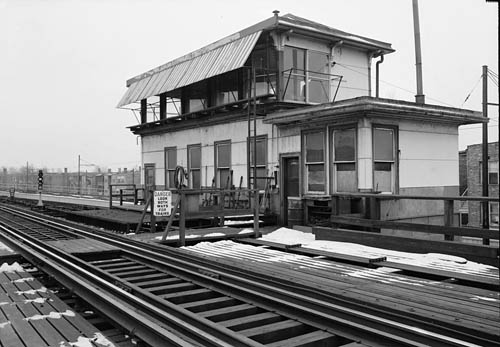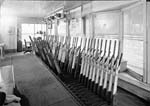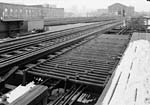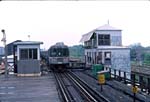|
|
 Wilson Tower, the last of the mechanical interlocking plants on the "L" system, is seen looking southwest in 1971. For a larger view, click here. (Photo by Jack Boucher, courtesy of the Historic American Engineering Record, Library of Congress) |
|
|
 Wilson Tower, the last of the mechanical interlocking plants on the "L" system, is seen looking southwest in 1971. For a larger view, click here. (Photo by Jack Boucher, courtesy of the Historic American Engineering Record, Library of Congress) |
Wilson
Tower
Sunnyside Avenue near Broadway, Uptown
Service Notes:

North Side Main Line
Quick Facts:
Established: June 1, 1900
Original Line: Northwestern Elevated Railroad
Rebuilt: 2007
Status: Demolished
History:
Wilson Tower was installed in 1900 when the Northwestern Elevated Railroad first began operation to control access to the tracks of the Wilson terminal station and to the north end of Wilson Yard. The two-story tower building was located on the west side of the main line right-of-way, cantilevered off the elevated structure. The building itself was fairly utilitarian in style, although it did have some ornamental brackets supporting the eaves of its hipped roof.
The interlocking plant it controlled was mechanical, with the switches and wayside semaphore signals controlled by large levers in the tower that were connected through a "locking bed" to a series of rods along track level that manipulated the switch points and signal arms. The locking bed consisted of steel bars forming a grid constructed so that, if the function controlled by a given lever conflicts with that controlled by another lever, mechanical interference is set up in the cross locking between the two bars, in turn preventing the conflicting lever movement from being made.
In an effort to reduce labor costs, the CTA began to decrease the hours of tower staffing in the 1950s where ever possible. On April 9, 1954, the hours of attended operation at Wilson Tower was reduced to 0700 to 2300 hours weekdays and 0900 to 1700 hours Saturdays. At all other hours trains routed on Tracks 1 & 4 from Wilson to Clark towers.
Because the four-track main line allowed a high level of service north and south of Wilson but narrowed to just two tracks through Wilson station, Wilson Tower (as well as Lawrence Tower north of Wilson station) represented a choke point on the North Side "L" for many years. By the late 1950s, the CTA decided it was finally time to correct the bottleneck that the track configuration through Wilson presented. The merging of trains in each direction down to one track was not only beginning to cause intolerable delays to service but the mingling of so many trains on so few tracks was one cause cited in the investigation of a 1956 accident at Wilson.
In 1958, the CTA embarked on a $1.8 million project to reconstruct about 1,500 feet of right-of-way through Wilson station into a continuous four-track system. Once complete, Evanston Express and North Shore Line trains would run on the outside tracks (Tracks 1 and 4 on the southbound and northbound, respectively) and North-South Route trains would remain on Tracks 2 and 3 on the inside. The project took several years to complete and involved some complicated phasing to allow service to continue through the site during the project. To make the job easier, Track 1 would use part of the existing concrete elevated structure used by CTA freight trains connecting to the Milwaukee Road.
With the new Track 4 completed and placed in service on April 19, 1961, the project was largely completed. Four tracks continuously through Wilson served by four platforms allowed for smoother operation without switching delays. Because trains would stay on their respective tracks the whole way through Wilson, Wilson Tower was no longer needed to route trains on the main line through the station. The tower was still needed, however, to route trains in and out of Wilson Yard.
As time went on, Wilson Tower saw less and less usage. Howard Yard became the primary North Side "L" yard, with Wilson Yard relegated to ancillary uses. Eventually, Wilson Tower and its interlocking plant became the last mechanical plant on the "L" operating most switches and semaphore signals by long rods without power assistance. By the 1990s, Wilson Yard was little used and the staffing the tower was severely reduced. On April 26, 1996, Wilson Interlocking set to provide through moves when towerman is not on duty, with straight main routes given on all four tracks. Trains could not be routed into Wilson Yard when Wilson Tower was not manned. On August 4, 1996, Wilson Tower was regularly staffed from 0900 to 1700 hours on Tuesdays and Fridays only in order to maintain tower availability.
On October 26 1996, a fire in the Wilson Shop facility which destroyed the maintenance building and severely damaged the adjacent yard. Several yard tracks were removed to allow the Chicago Fire Department access to the shop building. The Wilson shop and yard facilities were officially, permanently closed at 0600 hours, October 29 1996, due to fire damage. As a result, Wilson Tower had little reason to exist, since the yard it controlled access to was no longer in use.
On November 27, 1996, Wilson Interlocking was permanently removed from service. All switches were clamped in the normal position and the were signals hooded. The former Wilson interlocking tower was demolished over the weekend of April 18, 1998.
A New Wilson Interlocking
A few years later, work began on installing a new interlocking at Wilson. However, only a universal crossover -- a set of left- and right-hand crossovers -- between Tracks 2 and 3 were planned to be interlocked. A set of left- and right-hand crossovers between Tracks 1 and 2 and between Tracks 3 and 4 were to be hand-throw. Control of the interlocking was to be from a local panel in a prefabricated structure on an elevated platform.
The new crossovers were installed circa 1997, but the interlocking of the universal crossover between tracks 2 and 3 was not completed for a decade. Effective 9am, Thursday, January 4, 2007, the right and left hand crossovers between tracks 2 and 3 were placed in service as a full interlocking. Under normal circumstances the interlocking was placed on automatic; it could also be manually controlled from the tower. However, there were no wayside route selectors for Operators to use at Wilson Interlocking.
Changes During Wilson Reconstruction Project
Wilson Interlocking, and its set of right- and left-hand crossovers ("universal crossovers") between Tracks 2 and 3, were gradually taken out of service for construction phasing for the Wilson Station Reconstruction Project (as tracks were removed from service one at a time, and train routings were moved between the remaining three tracks, to keep service going during construction). The interlocking was then gradually placed back in service as the project concluded.
The Left-Hand Crossover between Track #3 and Track #2 has been temporarily removed from service at 2100 hours, Friday, March 18, 2015. The right-hand interlocked crossover, controlling movement between Track #2 and Track #3, was removed from service at 2200 hours, Friday, September 23, 2016. The switch has was clamped in the reverse position to facilitate Phase #3 of the Wilson Station Reconstruction Project. Effective 2200 hours, Sunday, November 5, 2017, the interlocking was fully removed from service; the left and right-hand interlocked crossovers Track #2 and Track #3 have been clamped in the normal position
Although not part of the interlocking plant, the the Wilson Left-Hand Crossover between Track #1 and Track #2 was permanently removed from service at 2100 hours, Friday, March 06, 2015. The crossover will be removed and the track straight railed.
In spring 2018, the interlocking began to be placed back in service. At 1400 hours, Saturday, May 5, 2018, the Wilson Interlocking signals were placed back in service, but for normal routes only; Wilson Interlocking remained out of service with the switches clamped and spiked in the normal direction. On Thursday afternoon, June 14, 2018, Wilson Interlocking was returned to service for all routes between Track #2 and Track #3; all switches that were clamped normal were unclamped.
Replacement with Montrose Interlocking
As part of the CTA's Red-Purple Modernization Program (RPM), a new interlocking is planned to be installed at Montrose. RPM's Lawrence to Bryn Mawr Modernization (LBMM) project includes replacement of the four-track embankment between Leland Avenue (south of Lawrence station) and Ardmore Avenue (between Bryn Mawr and Thorndale stations) with a new elevated structure, which would be built in halves (referred to as Stage A and Stage B by the project) so that two tracks can remain in service through the construction zone at all times. To achieve this, new interlockings are needed at the north and south ends of this zone to merge and sort trains transitioning between the 4-track and 2-track zones.
The interlocking at the south end of the LBMM area will be at Montrose Avenue. The new interlocking will include three diamond crossovers -- one between tracks 2 and 3 at the north end of the interlocking plant, and a pair between tracks 1 and 2 and between tracks 3 and 4 at the south end -- and a new tower.
The plan also included the decommissioning of Wilson Interlocking and removal of the two interlocked switches, as well as the two existing hand-throw switches near Montrose, preceding the installation of the new switches, which is in generally the same area as the old specialwork.
Effective 10pm, Friday, February 7, 2020, the interlocking at Wilson was removed from service. The four interlocking home signals and trips protecting the universal crossover between tracks 2 and 3 were removed from service. The two crossovers remained usable as hand-throw switches for the time being, but were normally clamped in the normal (tangent) position. The last use of one of the crossovers, as a manually-thrown switch, was the left-hand crossover in the pair, which was reversed during the first phase of a 3-week, multi-phase reroute to install the new Montrose Interlocking specialwork (crossovers), from 10pm, Friday June 5 to 10pm, Saturday, June 6. Both crossovers were removed during the week of June 7, 2020, replaced with a diamond crossover in the same general location as part of the new Montrose Interlocking.
The tower and relay house for the decommissioned interlocking, located on a steel platform along the west side of the elevated structure near Sunnyside Avenue, was removed the week of September 19, 2021. The relay house, which was located at track level, was lowered down to ground level on September 22; a smaller bungalow that had contained the local control tower panel that has been on an elevated platform above track level had been removed earlier. The old signal bungalow was relocated to Kimball Yard. Over the next few days, the steel platforms that had contained the buildings were dismantled, with demolition completed over the weekend of September 25-26.
 |
060784pv.jpg
(118k) |
 |
060785pv.jpg
(107k) |
 |
060786pv.jpg
(123k) |
 |
wilson15.jpg
(86k) |
|
|